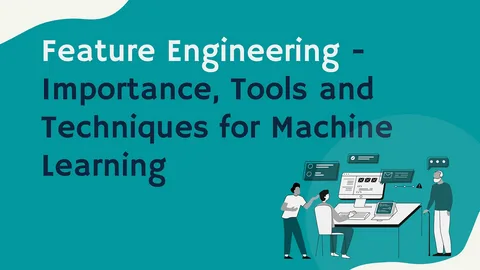Building high-performing models isn’t just about choosing the correct algorithm in the vast and evolving world of machine learning. Feature engineering is a crucial factor that often determines the success of any predictive model. As the bridge between raw data and machine learning models, feature engineering is vital in shaping how well your model interprets and learns from the data. For those embarking on a journey in machine learning through a Data Science Course, mastering the art of feature engineering is non-negotiable.
What is Feature Engineering?
Feature engineering transforms raw data into meaningful input features that improve the performance of machine learning models. This involves creating new features, selecting the most relevant ones, handling missing values, encoding categorical variables, scaling, and more.
The primary goal is to make the data more understandable to the model and expose hidden patterns that can enhance predictions. No matter how complex or powerful a model is, it will struggle to perform well if the input features are poorly structured or irrelevant.
Why Is Feature Engineering Important?
- Improved Model Accuracy
Better features lead to better insights. Well-engineered features help uncover data patterns, allowing the model to learn more effectively.
- Reduced Model Complexity
With the right features, even simpler models can outperform complex algorithms, reducing the need for computationally expensive models.
- Lower Overfitting Risk
By removing noise and irrelevant information, you can reduce the model’s tendency to memorise the data instead of generalising from it.
- Enhanced Interpretability
Sound feature engineering allows better understanding and visualisation of how models make predictions, essential for trust and transparency.
Key Techniques in Feature Engineering
- Handling Missing Values
Missing data is a common issue in real-world datasets. Some standard methods for handling them include:
- Mean/Median/Mode Imputation
- Using a distinct category (for categorical data)
- Predictive modelling to estimate missing values
Effective handling ensures the model doesn’t make biased predictions due to incomplete information.
- Encoding Categorical Variables
Machine learning models work best with numerical inputs. Categorical features can be transformed using:
- Label Encoding: Assigning a unique integer to each category.
- One-Hot Encoding: Creating binary columns for each category.
- Target Encoding: Using the target variable to determine category encoding.
Choosing the proper encoding method can significantly affect performance.
- Feature Scaling and Normalisation
Features measured on different scales can negatively influence distance-based algorithms like KNN or SVM. Scaling methods include:
- Min-Max Scaling
- Standardisation (Z-score normalisation)
This ensures that no feature dominates the model solely due to its scale.
- Binning and Discretisation
Binning involves converting continuous variables into discrete bins or intervals. For instance, age can be binned into “child”, “adult”, and “senior”. This can simplify models and reduce the impact of outliers.
- Feature Construction
This involves creating new features from existing ones to highlight hidden patterns. Examples include:
- Date-time breakdown: Extracting day, month, year, weekday, etc.
- Text features: Word count, character count, sentiment score, etc.
- Interaction terms: Multiplying or combining features to show relationships.
Effective construction can significantly boost model insights.
- Dimensionality Reduction
High-dimensional datasets can be noisy and computationally heavy. Techniques like Principal Component Analysis (PCA) and t-SNE help reduce the feature space while retaining maximum information.
- Feature Selection
Sometimes, less is more. Redundant or irrelevant features can harm performance. Feature selection methods include:
- Filter methods: Correlation, Chi-square tests
- Wrapper methods: Recursive Feature Elimination (RFE)
- Embedded methods: Regularisation (Lasso, Ridge)
Feature selection helps in building leaner and faster models.
Real-World Example: Feature Engineering in Action
Let’s consider a retail business trying to predict customer churn. The raw data includes purchase history, website activity, customer demographics, and feedback. With practical feature engineering, you could:
- Create a feature for the average purchase value
- Use the time since the last purchase
- Extract sentiment score from feedback text
- Encode loyalty program tier
- Bin age groups
Such refined features give your model the information it needs to make accurate predictions about customer churn, thus allowing the business to take proactive steps.
Common Pitfalls to Avoid
- Overengineering Features
Adding too many features can lead to overfitting. Always validate with cross-validation and test data.
- Ignoring Domain Knowledge
Features created without understanding the domain may miss critical insights. Collaborate with domain experts.
- Data Leakage
Avoid using information in feature creation that wouldn’t be available at prediction time (like future data). This leads to overly optimistic models that fail in production.
Tools for Feature Engineering
Many tools and libraries make feature engineering more efficient:
- Pandas & NumPy for basic manipulations
- Scikit-learn for preprocessing and feature selection
- Featuretools for automated feature engineering
- Kats and TSFresh for time series features
- NLTK and SpaCy for text feature generation
Automated feature engineering is evolving, but human creativity and domain understanding outperform automation in most complex scenarios.
Best Practices
- Start simple and iterate
- Begin with fundamental transformations and gradually add complexity.
- Use visualisation
- Understand feature distributions, correlations, and relationships using plots.
- Keep track of transformations
- Maintain pipelines using tools like scikit-learn Pipeline or Feature-engine.
- Document everything
- Good documentation ensures reproducibility and helps in debugging.
Conclusion
Feature engineering is where art meets science in machine learning. While algorithms and tools evolve, the power of thoughtfully created features remains unmatched. Mastering this skill requires practice, experimentation, and a solid foundation in data handling and domain understanding.
For those aspiring to become successful data professionals, enrolling in a structured and data-oriented data scientist course in Hyderabad can be a great way to develop the necessary expertise. Such programs typically cover feature engineering and the entire data science lifecycle, setting you up for real-world success.
ExcelR – Data Science, Data Analytics and Business Analyst Course Training in Hyderabad
Address: Cyber Towers, PHASE-2, 5th Floor, Quadrant-2, HITEC City, Hyderabad, Telangana 500081
Phone: 096321 56744


